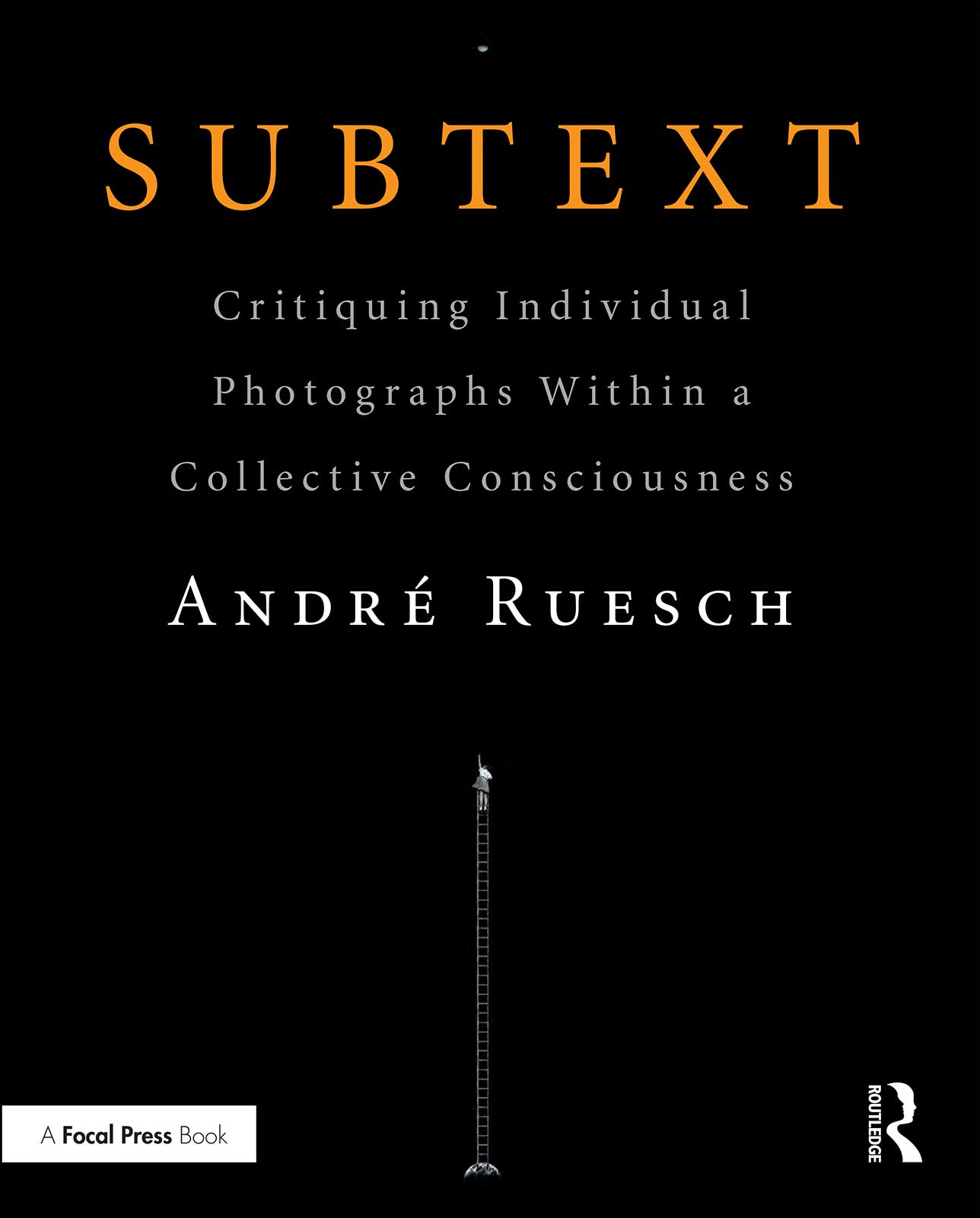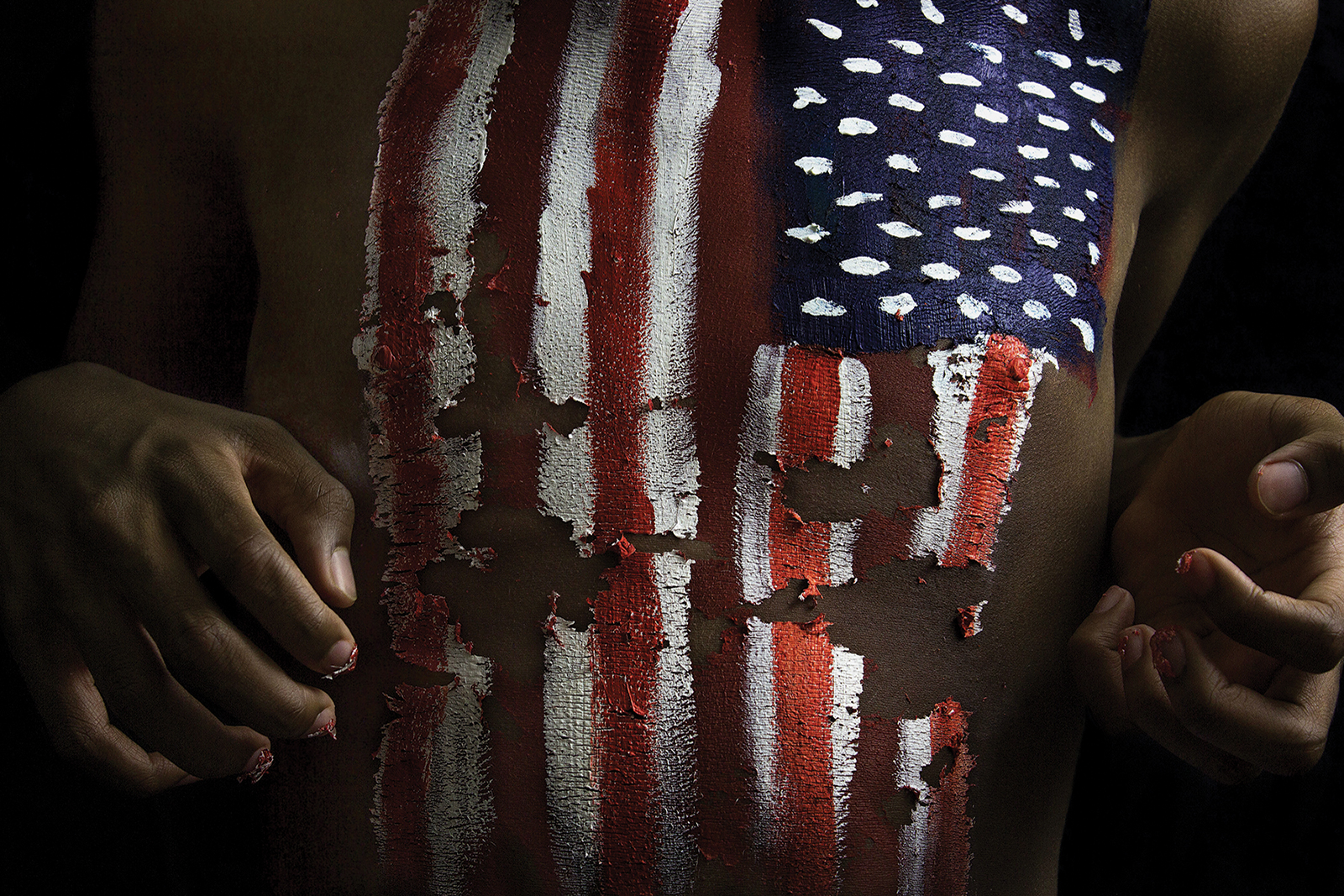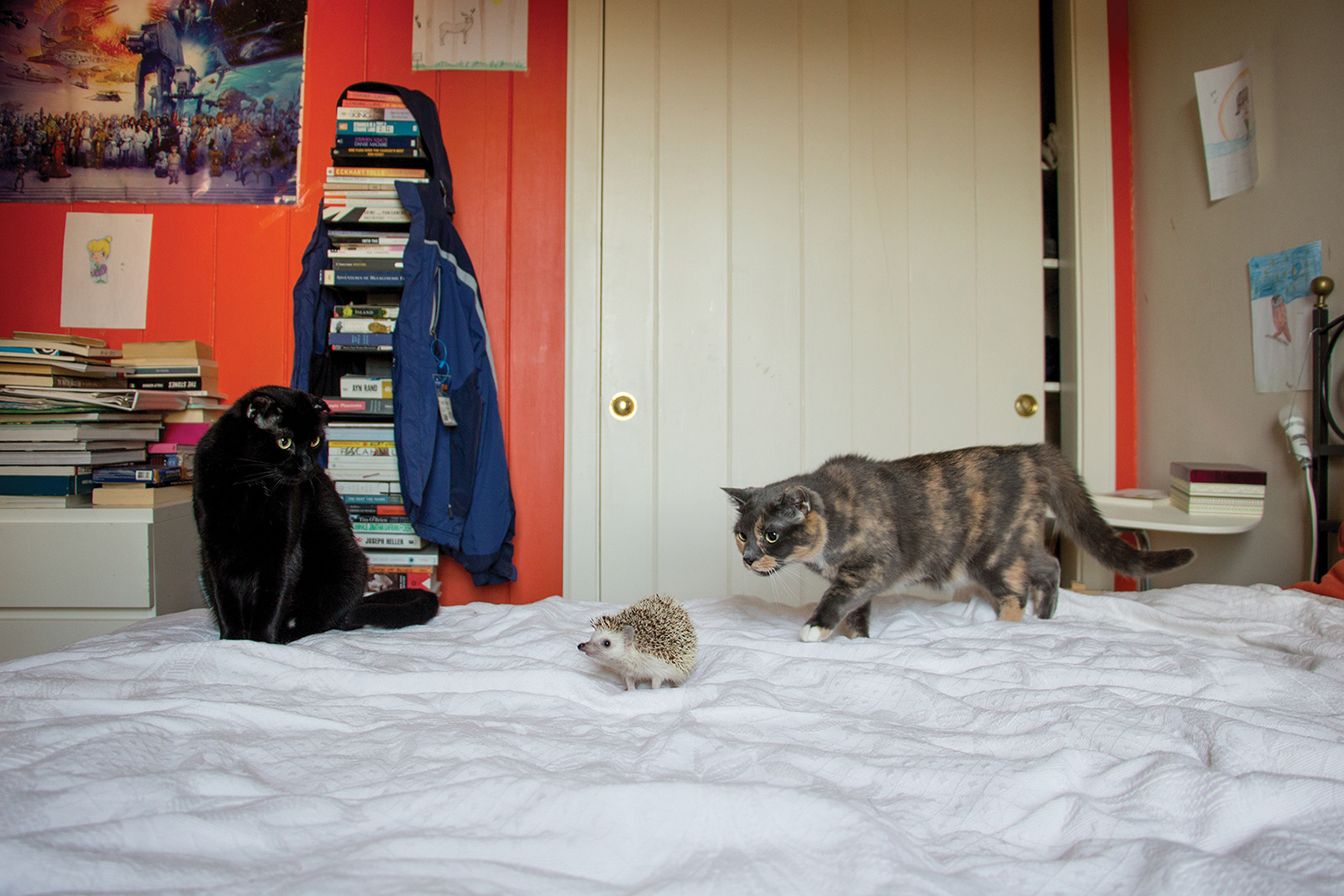SUBTEXT – CRITIQUING INDIVIDUAL PHOTOGRAPHS WITHIN A COLLECTIVE CONSCIOUSNESS
André Ruesch
Focal Press, 2017
Review by Lauren Greenwald
Issue 106
On Critiques … and Subtext
A conversation with André Ruesch
The Critique. We’ve all experienced it, in some form or another – the institutional academic critique, the portfolio review, or just a casual conversation with a peer.
At a certain point, all artists must take what we have made and introduce it to the world. And those of us who have experienced more than one of these critiques know that they vary wildly in structure, content, and result.
As a teacher, I spend a lot of time thinking about the nature of critiques. To what purpose am I holding them, how they are organized, how might I change them to suit the needs of the class, or the individual? I often begin the semester by asking my students what they think the word “critique” means. I get a variety of answers – and too many view it as a pejorative thing. But in arts education, the critique is an integral part of the landscape. We agree that it is considered important for artistic development, but the how and why is seldom discussed. When I was in graduate school, I found every professor had a different way of leading critique, and as a student, it always seemed a bit of a crap shoot – some were enormously helpful, others fabulously demoralizing. If you want to read about a hilarious, wildly extreme version of the studio critique, read Sarah Thornton’s Seven Days in the Art World - her chapter “The Crit” recounts a marathon graduate crit session at CalArts.
I find myself constantly researching how others write about and talk about art, and have an arsenal of books on this subject. For many of my colleagues, and for myself, Terry Barrett’s excellent Criticizing Photographs is a touchstone reference. In particular, his chapter, Describing Photographs, is a great introduction to looking at and talking about art, and he discusses the studio critique in marvelous detail in the final chapter of the book. But I find that students are often resistant to reading an entire book about this topic, and many simply refuse to do so. I typically resort to cherry picking chapters and essays from a variety of sources and methods, something I feel rather guilty about, but that’s my reality.
So I was delighted to hear recently about a new book on the topic, Subtext by André Ruesch. Published last year by Focal Press (part of Routledge), this book approaches the critique from a case study perspective. The interesting thing about this book is that it offers real examples of student work – with an in-depth response (reproducing the content of a critique) following each. The Foreward was contributed by the late Patrick Nagatani, in the form of a conversation between himself and his alter ego, Ryoichi. As an educator for almost 40 years, in the interview he laments what he calls the “regular jargon of “art words” that at times can easily fit into anyone’s work.” He notes that, “Feedback is usually rushed, formalistic, mediated, and derivative.” If you’ve ever participated in a portfolio review, you’ve likely encountered those reviewers who spend the entire time picking apart technical flaws or rattling off a long list of artists you should know.
A mentor to Ruesch from his graduate school days, Nagatani watched him develop over many years and was intimately acquainted with how Ruesch works with students and how he conducts his critiques, which he says, “weaves together ideas in honest and risk taking analysis.” He remarks, “Hopefully with this book the reader will be anchored in thinking about the reciprocity between global and personal and how perspective changes depending from where you are looking and reading.”
Untitled. © Vanessa LeRoy
Untitled. © Anni Abbruzzese
Wire Sketches. © Liz Ellenwood
Untitled. © Christine Delay
The book is organized simply – with an Introduction, Prologue, and a two-part Epilogue bookending 35 chapters, each discussing a different student work. The Introduction outlines Ruesch’s approach to critique, working in the method that he calls a reverse critique. Work is hung individually, and the artist is not allowed to speak until the end. All students are required to comment. He stresses the importance of visual literacy, and the power subtext has within an image.
The organization of each chapter is the same – an image is presented at the beginning, and the following analysis is broken down into subheadings – What Are We Looking At?, Identify the Elements, Contextual Meaning of the Elements, How Can the Image Be Interpreted?, a Conclusion, and a delightful closing element, titled Assignments you May Want to Challenge Yourself With, in which several bullet points regarding conceptual and theoretical elements of the work are presented. In reading these chapters, you get the sense that you are seeing the ideas unfold as they do in the best critiques - one idea begets another and the associations fly fast and thick. His is a book for students and teachers alike. I find it tremendously useful to look at an example of student work, and see how a real group of people, professor and fellow students, have responded to it. I’ve always enjoyed watching other professors lead critiques, and it’s one of my favorite things about portfolio reviews - to see how other people respond to work and what ideas come about. While the number of examples here and the same treatment of each is may seem repetitive at first glance, the magic of this setup is that case by case, the many different examples of work are analyzed in the same manner, reinforcing and elaborating on this method of examining images. Again, I can’t stress enough how refreshing it was to see student work in a publication. Taken from Ruesch’s classes at the Santa Fe Community College and Lesley University, where he currently is a Professor of Photography, the work varies wildly in form and content. But that’s part of the appeal. I imagine being a student reading this, and receiving a welcome flash of recognition in seeing an idea or approach I may have considered at one point. The simple, straightforward way of breaking down the analysis reminds me of Visual Thinking Strategies (VTS), developed by museum educator Philip Yenawine, a strategy meant to be used by all ages, of all levels of exposure to art, to develop critical thinking and communication skills. It all begins with a very simple, deep viewing and description of what we see in this work of art. Interpretation comes only after a concentrated and focused period of detailing what is visible in the work. I’ve used it with many of my classes, and it’s fun, collaborative, and amazingly effective.
I was fortunate enough to have a conversation with Ruesch recently, and to learn more about the book and his ideas leading up to this. I’m pleased to be able to share the following excerpts from our talk.
I, of course, began by asking how the book came to be, particularly because this is the first book of this kind he’s written. At Lesley University, Ruesch has been teaching the 1st year experience, a course in humanities, along with photo courses. One recurring question is in noting that for students, visual literacy is generally not taught or encouraged, and is hyper-mediated – so how do we educate students in visual culture in general? It’s a question most art professors would say is achievable by taking a class in studio art – indeed, according to a mature student who took one of his photo classes at Santa Fe Community College, “the class changed how he looked at the world … not just art.”
Regarding the idea for this particular book, he responded that he never saw himself as a writer, but in teaching, and trying to find books for students, he found that many of the examples had the same works that were codified and culturally approved. And students had much more to say for themselves than he anticipated. He found that students weren’t reading the books he selected for them, but seemed to prefer what was said in critiques. They suggested he record the critiques and make a YouTube channel. Concerned this would alter the dynamic and genuine nature of the interactions, writing them down instead seemed preferable. So when he began in earnest to write, he tasked himself to use accessible language – in his view, a problem with all disciplines in academia is that people are encouraged to develop ideas in relation to what is already written. The book is jargon-free very deliberately, and when references to other artists or work are made, it is incorporated into the text. The book is also not organized to demand being read linearly - the reader should be able to pick and choose what is read – they can flip through the book, and when they see an image that interests them, they take a closer look. When he said this I laughed, as it was precisely what I had done in reading the book. We are naturally attracted to certain images over others, but I found that once I had explored the ones that caught my eye initially, I was even more interested in reading about the others.
We also talked quite a bit about how we, as artists work, and what goals we, as teachers, really have for our students. Ruesch’s view is that in the beginning, many of us are working intuitively, and can’t begin to talk about context without first understanding subtext. We can generally agree that from any body of many images, different sequencing and editing creates different story lines. But when discussing a student’s work, many educators immediately suggest the student look at various artists in whose work they see similarity. The problem, as Ruesch explained, is that by presenting a student just beginning a project with someone else’s fully resolved work, it, in his words, “cauterizes the initial initiative and fragile inquiry.”
He went on to note that we have an innate desire to sort and organize information, to create an ontology, or taxonomy, of what we’re seeing. He recognizes that it’s challenging not to respond to or talk about work by placing it within a genre, as he says, “… while it can be helpful to put like with like, it can be very interesting to put like with other.” In developing projects, students are so often asked to focus on intentionality, but taking intellectual risks means you don’t always know what the intention is yet. If we think of work predominantly as a success or failure – by whose criteria are we judging this and to what end? He observed that critiquing is often considered taboo or unpatriotic in relation to politics in the US, but it’s our responsibility to question things, even those we believe in.
He elaborated, “We are moved by art – we don’t always know why, but we know this dynamic exists. To follow those ideas and encourage development of a viewpoint is important. The taxonomy of traditional art critique doesn’t necessarily lead down that road, and we are sending contradictory messages – dissecting the thing rather than observing it.” It’s another common element in critiques that we reject the idea of getting off topic … but “ … what is topic? How is it defined? How will we have new ideas if not by getting off topic?”
And it’s true. What is that magical progression of inspiration, execution, and development? Why is it so elusive? It’s exhilarating and invigorating and sometimes a dismal failure, but that’s also part of the magic. A question I also ask myself quite often, and I posed it to Ruesch, is, why study art at all? At a time when institutions of higher learning seem more like corporations intent on serving the customer, the student, why should students study art? And, as we observed, today every student can learn how to do just about anything by looking it up on Google, so why go to school for art? What’s the point? Ruesch’s response was brilliant. “It has to do with a combustion of thought (found there).”
Nagatani closes his forward with a passage from the book, which I think is particularly resonant and I’ll echo here. Ruesch writes, “The journey into the heart of images should be an adventure for both maker and viewer. Each time we set sail we can’t know where it will lead us. Like most adventures this can be perilous and enchanting and probably both.”
Exactly. This book is a must for students, teachers, and artists alike.
Lucy. © Andrea Jones
Untitled. © Eleanor Rappe
Untitled. © Anouk Jutta
Untitled. © Jon Lewis
Lauren Greenwald iss an Assistant Professor of Photography at the University of South Carolina.
She lives and works in Columbia, SC.









